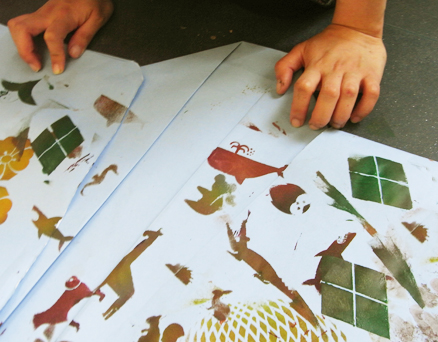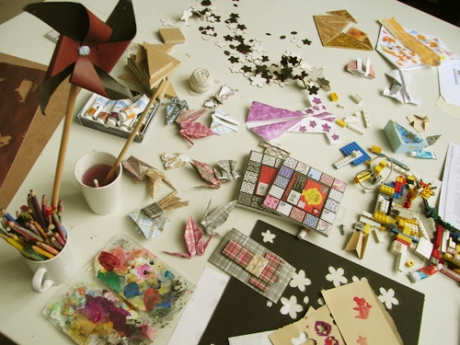Pittenweem Art Festival
August 17, 2011
Great people, Great time!
Making Culture” Kimono Making Toolkit
March 2, 2011
The toolkit consists of 5 parts:
1, the stencils and roller: Using stencils to print pattern on kimono is a technique used in Japan from 600 years ago. The motifs used for the stencil and stamps collection in this toolkit were based on traditional designs that were used for making Japanese family crests which are known as Kamon. These motifs covered almost every aspect of traditional Japanese life: clothing, food, shelter, transportation, sports, and most importantly, nature.
By playing with these patterns, the children could have a glimpse of the exotic culture from a country hundreds of years ago.
2, stamps and inkpad: stamps are another way to print pattern by traditional Japanese craftsmen. The 4 stamps here represent spring, summer, autumn and winter using the most significant kimono motif of the seasons.
3, origami making paper: there are various papers in the toolkit with different culture significance.
4, a set of Japanese tangram stamp: The tangram is a dissection puzzle consisting of seven flat shapes which are put together to form shapes. The objective of the puzzle is to form a specific shape (given only in outline or silhouette) using all seven pieces. This is suggested to help the children to foster critical thinking, spatial rotation skills, and an intuitive sense of geometry.
5, handbook: the hand book is an essential part of the toolkit which serves not only as instruction guide but also a journal for educators to collect useful information during the learning process.
Above: other than workshop instructions, knowledge points and teacher’s journal, the handbook also includes detailed explanation of props and motifs used.
The special thing about this way of learning is that it uses garment as media, which is familiar and approachable for children. The whole playing/learning experience is visual and interactive, which enable the children to raise interests, also easier for children with linguistic or writing difficulties to exercise story telling skills.
This is also an open-source learning process, the educator/ facilitator is able to collect data and information during the process for better observation and analyze. At the mean time, they can channel the learning into directions fitting children’s interest and need. This is not a single – serving learning experience but a keep-on-develop one that can lead to new inspiration every time it is used.
this project was recognized by British craft council as part of the Craft Action Network, or ‘CAN’, a national participation and learning network for contemporary craft.
little story teller
August 9, 2010
tool kit
July 31, 2010
BJ’s Workshop Brief Review
July 16, 2010
Theme and…
July 3, 2010
When Debra (11) was asked what her favorite painting is as we were chatting, she said: “Monet’s water lilies…Because the blue is nice, and I like pond”.
Then I thought it might be a good idea for children to create kimono of their own theme. Like a blank piece of canvas, the kimono served as media to show sceneries in life since ancient times, especially the change of time and nature. Certain color and motif are used to describe certain season. If this culture and quality can be embed into the workshop that would be even more interesting! The outcomes, on the other hand, can have less chance to be out of control.
the previous prototypes are good examples of why control is kind of important…
I can preset the tone and color swatch of the back ground, let children fill it up while learning the meaning and significanece of certain color.
then let them learn about motif by stencil printing decoration… (and they can use some of their favourite modern patterns as well!)
tips:
Afternoon with Dirk
June 30, 2010
7 years old Dirk is an energetic primary school student and art lover who provided a lot of advices on how to make the origami kimono more wearable.
Tip from today:
It might be interesting to divide the kimono making into 2 stages: 1, shaping and coloring; 2 pattering and free-style drawing. I can preset the tone of color and category of pattern harmoniously for kids to play in order to give the outcomes a little bit and also taught them the significance of certain color and motif more systematically.
Full Size Fun
June 25, 2010
what can children learn from making a life size origami kimono and printing pattern?
cultural: style, aesthetics, technique, symbol, recognition and curiosity.
communicational: team work, coordination and division of labour.
artistic: pattern, color,stucture, pattern arrangement.
and according to our little friend who leads the workshop today,making something bigger than you can handle with others is great fun:) he also suggested DIY unique school uniform like this, Can this idea be part of my final outcomes?
notes:
don’t underestimate children, they actually prefer complex and sophisticated patter than simple ones;
they can recognize and take credit of thier own contribution in the completed big picture and be really proud of them;
never scare of getting messy;
kids love rollers.
A little gift to remember with 🙂
One step further!
June 22, 2010
Observation: DCA craft making night
Do-it-youself family session
Can I embed my workshop into DCA’s Summer Craft Activites?
Also, thanks for the “Get Creative” Craft Class, I learned to draw techniques from Japanese Woodblock Printing and papermaking that can be used in the workshop!
P.S: Get digital for Ceara’s project.








































